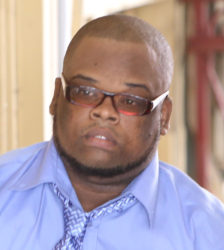At Travis McDougall’s trial yesterday for the murder of Ashok Raghoo, Police Corporal Derwin Eastman could not account for video footage he claimed to have seen and the presiding judge ordered that the prosecution make every effort to have it presented
McDougall is accused of murdering the businessman during an alleged robbery on August 18, 2014, at Vlissengen Road. He has pleaded not guilty to the indictment. Eastman yesterday told Justice Navindra Singh and the jury, that based on information received, he viewed CCTV footage looking for a purple helmet which he “observed…”

Before completing his sentence of what he was claiming to have observed, defence attorney Nigel Hughes raised an objection that the witness may possibly be relating “hearsay” testimony.
Counsel advanced that unless the prosecution would be in position to produce the supposed footage to the court, then Eastman should not be allowed to complete what he was about to say.
Justice Singh then enquired from Prosecutor Tuanna Hardy whether the state was in possession of the footage to be presented to the court.
In response, Hardy asked the witness “do you know where that footage is today?” His answer was “no.”
The corporal conceded Hughes suggestion under cross-examination, that right up to the point of his testimony yesterday morning, he had never produced the footage he claimed to have seen—not even during the preliminary inquiry (PI) at the Magistrates Court.
Hughes then asked him whether it was not also true that the Magistrate had requested he produce the footage. After momentarily gazing at the ceiling, however, Eastman said he could not recall.
Asked where the camera containing the footage he spoke of was mounted, in relation to the scene of the crime, Eastman, who described himself as an intelligence gathering rank, said it was located some 400 yards away.
Asked if that camera had been located at the Rubis Gas Station, the policeman said it was, adding that it was atop a pole, pointing directly onto the road in front of gas station, “about 300 to 400 yards” away from the scene of the shooting which occurred at the traffic light at the entrance of the Botanical Gardens.
Asked whether there was anything preventing him from producing the footage during the PI, Eastman told Hughes, “Sir, it wasn’t my calling.”
Further pressed as to whether anything hindered him from producing it at the current trial, the smiling corporal responded “if it could be found…” Hughes, however, immediately interrupted, asking him to answer exactly what he had been asked.
It was only after the judge had intervened, that Eastman said no, there is nothing preventing him from producing the footage. Asked why he did not so do, he told Justice Singh, “because I don’t have a copy,” though he agreed with counsel, that it was a “vital piece of evidence.”
According to the witness after viewing the footage at the Criminal Investigation Department (CID) Headquarters at Eve Leary in 2014, he never saw it back. Asked if it had disappeared, he told Hughes, “I can’t say.”
Questioned as to whether he had ever shown the footage to the accused, Eastman said he never did. His answer was the same when asked if he had ever made a request to have the footage presented to the court.
As to if he personally knew of any eyewitness or supposed eyewitness viewing the footage, Eastman said he is not aware.
When asked what he would have to do to have the footage, Eastman explained a process of making a request to his superiors; though he said he was not too familiar with the procedure.
The intelligence gathering rank, who told the court that he had a copy of the footage on his personal cellphone, was then asked to explain the procedure he had to go through before being in possession of it.
He initially said that he had “snapped it” with his phone, but later said it was sent to him. Hughes then rhetorically asked, “and let me guess, that cellphone was stolen, right?”
But Eastman quickly responded “No, it was damaged”
Asked how he was initially able to view the footage, the witness said he just “went into CID and look at it.” He thereafter agreed with Hughes’ suggestion, that the process for getting a copy of the footage was not as tedious as he had previously explained.
Asked if he could recall his client’s relatives protesting his arrest, arguing that Mc Dougall was at home at the time of the shooting, Eastman told Hughes he could not remember, but later definitively said they did not.
“So, they just stood there and said nothing while he was being arrested?” Hughes asked, to which Eastman replied “yes.”
Following a request from Hughes to have the footage produced, Justice Singh ordered the prosecution to make every effort to have it presented to the court.
On Tuesday, crime scene investigator Mark Gasper, had testified to CCTV cameras being in the immediate vicinity of the crime scene. He, however, told Hughes that he did not pay attention to them, nor the direction in which they were pointing.
The helmet Eastman had earlier spoken of, was tendered in evidence. He told the court that it was found “in the presence of the accused.”
When asked by Hughes, the witness confirmed that Mc Dougall did indeed tell him that he owned two purple helmets.
In her opening address, Hardy had said that Raghoo and his wife had left their home to transact business in the city. She said they were driving along Vlissengen Road and had stopped at a traffic light when they were both shot and relieved of their belongings.
They were rushed to the hospital where Ashok succumbed to his injuries.
Police say that they were robbed of a firearm, a quantity of cash and cellphones; all totaling $4M.